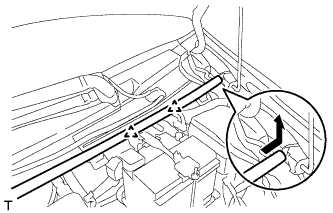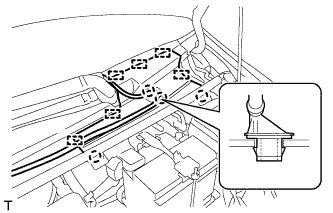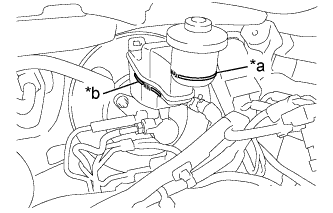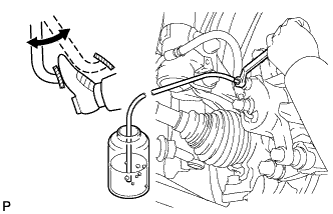Brake Fluid (For Hatchback) -- Bleeding |
- NOTICE:
- Immediately wash off any brake fluid that comes into contact with any painted surfaces.
- HINT:
- If any work is done on the brake system or if air in the brake lines is suspected, bleed the air from the system.
| 1. REMOVE CENTER COWL TOP VENTILATOR LOUVER |
 |
Disengage the 2 clips and slide the hood to cowl top seal as shown in the illustration.
Disengage the 2 claws and separate the washer hose joint.
- NOTICE:
- To prevent washer fluid from contaminating the brake master cylinder reservoir, do not separate the washer hose.
 |
Disengage the 2 claws and 6 guides remove the cowl top ventilator louver center.
| 2. FILL RESERVOIR WITH BRAKE FLUID |
Fill the reservoir with brake fluid.
Text in Illustration *a MAX Line *b MIN Line - Fluid:
- SAE J1703 or FMVSS No. 116 DOT3
- NOTICE:
- Add brake fluid to keep the level between the MIN and MAX lines of the reservoir while bleeding the brakes.
 |
| 3. BLEED BRAKE MASTER CYLINDER SUB-ASSEMBLY (w/o VSC) |
- HINT:
- If the master cylinder has been disassembled or if the reservoir becomes empty, bleed the air from the master cylinder.
Using a union nut wrench 10 mm, separate the 2 brake tubes from the master cylinder.
 |
Slowly depress the brake pedal and hold it there (Step A).
 |
Block the outer holes with your fingers, and release the brake pedal (Step B).
 |
Repeat Steps A and B 3 or 4 times.
Using a union nut wrench 10 mm, install the 2 brake tubes into the master cylinder.
- Torque:
- 15 N*m{155 kgf*cm, 11 ft.*lbf}
- NOTICE:
- Use the formula to calculate special torque values for situations where a union nut wrench is combined with a torque wrench (YARIS_NCP93 RM00000482L007X.html).
 |
| 4. BLEED BRAKE MASTER CYLINDER SUB-ASSEMBLY (w/ VSC) |
- HINT:
- If the master cylinder has been disassembled or if the reservoir becomes empty, bleed the air from the master cylinder.
Using a union nut wrench 12 mm, separate the 2 brake tubes from the master cylinder.
 |
Slowly depress the brake pedal and hold it there (Step A).
 |
Block the outer holes with your fingers, and release the brake pedal (Step B).
 |
Repeat Steps A and B 3 or 4 times.
Using a union nut wrench 12 mm, install the 2 brake tubes into the master cylinder.
- Torque:
- 20 N*m{199 kgf*cm, 14 ft.*lbf}
- NOTICE:
- Use the formula to calculate special torque values for situations where a union nut wrench is combined with a torque wrench (YARIS_NCP93 RM00000482L007X.html).
 |
| 5. BLEED BRAKE LINE |
- NOTICE:
- Bleed the brake line of the wheel farthest from the master cylinder first.
- Add brake fluid to keep the level between the MIN and MAX lines of the reservoir while bleeding the brakes.
Connect a vinyl tube to the bleeder plug.
 |
Depress the brake pedal several times, and then loosen the bleeder plug with the pedal depressed (Step C).
At the point where the fluid stops coming out, tighten the bleeder plug, and then release the brake pedal (Step D).
Repeat Steps C and D until all the air in the fluid is completely bled out.
Tighten the bleeder plug.
- Torque:
- Front Brake:
- 8.3 N*m{85 kgf*cm, 73 in.*lbf}
- Rear Brake (for Drum type):
- 8.5 N*m{87 kgf*cm, 75 in.*lbf}
- Rear Brake (for Disc type):
- 11 N*m{112 kgf*cm, 8 ft.*lbf}
Repeat the above procedure to bleed the air out of the brake line for each wheel.
| 6. BLEED BRAKE ACTUATOR ASSEMBLY |
- NOTICE:
- After bleeding the air from the brake system, if the height or feel of the brake pedal cannot be obtained, perform air bleeding of the brake actuator with the Techstream by following the procedure below.
Depress the brake pedal more than 20 times with the engine off.
Connect the Techstream to the DLC3, and turn the ignition switch to ON.
- NOTICE:
- Do not start the engine.
Select "Air Bleeding" on the Techstream.
- HINT:
- Refer to the tester operator's manual for further details.
Bleed the air out of the brake line when Step 1: Increase appears on the Techstream display.
- NOTICE:
- Bleed the air by following the steps displayed on the Techstream.
- Make sure that the master cylinder reservoir tank does not become empty.
Connect the vinyl tube to either one of the bleeder plugs.
Depress the brake pedal several times, and then loosen the bleeder plug connected to the vinyl tube with the pedal depressed (Step E).
When fluid stops coming out, tighten the bleeder plug and release the brake pedal (Step F).
Repeat Steps E and F until all the air in the fluid is completely bled out.
Tighten the bleeder plug completely.
- Torque:
- Front Brake:
- 8.3 N*m{85 kgf*cm, 73 in.*lbf}
- Rear Brake (for Drum type):
- 8.5 N*m{87 kgf*cm, 75 in.*lbf}
- Rear Brake (for Disc type):
- 11 N*m{112 kgf*cm, 8 ft.*lbf}
Repeat the above procedure for each wheel to bleed the air out of the brake line.

Bleed the air out of the suction line when Step 2: Inhalation appears on the Techstream display.
- NOTICE:
- Bleed the air by following the steps displayed on the Techstream.
- Make sure that the master cylinder reservoir tank does not become empty.
Connect the vinyl tube to the bleeder plug at the right front wheel or the right rear wheel and loosen the bleeder plug.
Operate the brake actuator to bleed the air using the Techstream (Step G).
- NOTICE:
- Release the brake pedal at this time.
- HINT:
- This operation stops automatically after 4 seconds.
Check if the operation has stopped by referring to the Techstream display and tighten the bleeder plug (Step H).
Repeat Steps G and H until all the air in the fluid is completely bled out.
Tighten the bleeder plug.
- Torque:
- Front Brake:
- 8.3 N*m{85 kgf*cm, 73 in.*lbf}
- Rear Brake (for Drum type):
- 8.5 N*m{87 kgf*cm, 75 in.*lbf}
- Rear Brake (for Disc type):
- 11 N*m{112 kgf*cm, 8 ft.*lbf}
Repeat the above procedure for the other wheels to bleed the air out of the brake line.
Bleed the air out of the pressure reduction line when Step 3: Decrease appears on the Techstream display.
- NOTICE:
- Bleed the air by following the steps displayed on the Techstream.
- Make sure that the master cylinder reservoir tank does not become empty.
Connect a vinyl tube to either one of the bleeder plugs.
Loosen the bleeder plug (Step I).
Using the Techstream, operate the brake actuator assembly, completely depress the brake pedal and hold it there (Step J).
- NOTICE:
- During this procedure, the pedal will feel heavy, but completely depress it so that the brake fluid comes out of the bleeder plug.
- Hold the brake pedal depressed. Do not depress and release the pedal repeatedly.
- HINT:
- The operation stops automatically after 4 seconds. When performing this procedure continuously, set an interval of at least 20 seconds.
- When the operation is complete, the brake pedal goes down slightly. This is a normal phenomenon caused when the solenoid opens.
Tighten the bleeder plug, and then release the brake pedal (Step K).
Repeat Steps I to K until all the air in the fluid is completely bled out.
Tighten the bleeder plug.
- Torque:
- Front Brake:
- 8.3 N*m{85 kgf*cm, 73 in.*lbf}
- Rear Brake (for Drum type):
- 8.5 N*m{87 kgf*cm, 75 in.*lbf}
- Rear Brake (for Disc type):
- 11 N*m{112 kgf*cm, 8 ft.*lbf}
Repeat the above procedure for the other wheels to bleed the air out of the brake line.
Bleed the air out of the brake line again when Step 4: Increase appears on the Techstream display.
- NOTICE:
- Bleed the air by following the steps displayed on the Techstream.
- Make sure that the master cylinder reservoir tank does not become empty.
Connect the vinyl tube to either one of the bleeder plugs.
Depress the brake pedal several times, and then loosen the bleeder plug connected to the vinyl tube with the pedal depressed (Step L).
When fluid stops coming out, tighten the bleeder plug, then release the brake pedal (Step M).
Repeat Steps L and M until all the air in the fluid is completely bled out.
Tighten the bleeder plug.
- Torque:
- Front Brake:
- 8.3 N*m{85 kgf*cm, 73 in.*lbf}
- Rear Brake (for Drum type):
- 8.5 N*m{87 kgf*cm, 75 in.*lbf}
- Rear Brake (for Disc type):
- 11 N*m{112 kgf*cm, 8 ft.*lbf}
Repeat the above procedure for the other wheels to bleed the air out of the brake line.
Make sure that the air bleeding is complete by referring to the Techstream display and turn off the Techstream.
Disconnect the Techstream from the DLC3.
Turn the ignition switch off.

| 7. INSPECT FOR BRAKE FLUID LEAK |
| 8. INSPECT FLUID LEVEL |
Check the fluid level.
If brake fluid level is lower than the MIN line, check for leaks and inspect the disc brake pads. If necessary, refill the reservoir with brake fluid to the MAX line after repair or replacement.Text in Illustration *a MAX Line *b MIN Line - Fluid:
- SAE J1703 or FMVSS No. 116 DOT 3
 |
| 9. INSTALL CENTER COWL TOP VENTILATOR LOUVER |
 |
Engage the 2 claws and 6 guides and install the cowl top ventilator louver center.
Engage the 2 claws and install the washer hose joint.
Engage the 2 clips and slide the hood to cowl top seal as shown in the illustration.
 |